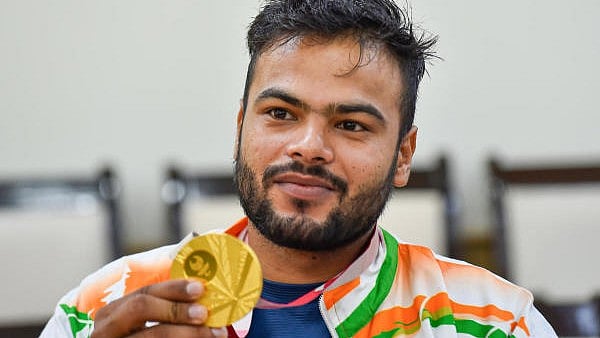
Indian javelin thrower Sumit Antil.
Credit: PTI Photo
As the countdown begins for the World Para Athletics Championships in India, it is imperative that para-athletes are treated equitably—
on par with their able-bodied counterparts.
The 12th edition of the World Para Athletics Championships will be held in New Delhi from September 27 to October 5, making it the largest para-sporting event ever hosted in India. Over 1,000 athletes from 100 countries are expected to participate.
India’s para-athletes have consistently made the country proud—often outperforming their able-bodied peers. At the 2024 Paralympics in Paris, they brought home 29 medals, including seven golds, ranking 18th among 169 participating nations. India returned from the Paris Olympics 2024 with six medals without a gold, standing 71st out of 91 participating countries.
Despite their achievements, para-athletes continue to receive less recognition, support, and encouragement.
Take a recent example. Two major athletic events were held in Bengaluru in July: the Neeraj Chopra Classic 2025 International Javelin Meet and the Indian Open Para Athletics Championship. While Neeraj Chopra—an Olympic gold and silver medallist—drew a crowd of nearly 15,000 spectators, the turnout to watch Sumit Antil—a double Paralympic gold medallist in javelin—was far more subdued. Similarly, in shooting, double Olympic double bronze medallist Manu Bhaker is a household name, while Avani Lekhara—winner of two Paralympic golds—remains relatively less known.
This is the bitter irony India must reckon with.
According to the 2011 Census, India is home to 26.8 million persons with disabilities, accounting for 2.2% of the population. However, more recent estimates from the National Family Health-5 Survey suggest the actual figure may be close to 4.5%.
Persons with disabilities in India face multiple challenges—lack of accessible infrastructure, limited transportation, inadequate healthcare and rehabilitation services, and barriers in education and employment.
Sadly, educational institutions in India lack sporting facilities for persons with disabilities. Even the opportunity to participate in annual sports or games is rare. Moreover, there is a lack of technology and multi-sensory essentials to enhance potential talent and ensure effective participation of persons with disabilities.
Despite these systemic barriers, India’s para-athletes have excelled internationally through sheer hard work and determination. The Paralympics are no less competitive than the Olympics, with thousands of athletes from over 100 countries—many developed ones—competing for those coveted medals.
What makes their achievements even more remarkable is that most of India’s para-athletes are from humble backgrounds and rural or semi-urban areas where sporting facilities are sorely lacking.
Haryana’s Sumit Antil was an avid sportsman until 2015, when a bike accident led to the amputation of his left leg below the knee. Despite this setback, he returned to sports with the aid of a prosthetic leg and excelled at the national and international levels.
Avani Lekhara suffered a life-altering road accident at age 11, which left her wheelchair-bound since 2012. But her resilience, determination, and her father’s support saw her achieving several milestones in shooting.
BroBronze medallisteetal Devi, born without arms, showed physical limitations are no barrier to achieving greatness by shooting with her legs.
Archery gold medallist Harvinder Singh was barely two years old when he contracted dengue. The side effects of a botched treatment left both his legs impaired. Inspired by Paralympians, he took to archery.
Indeed, para-athletes are slowly gaining recognition and support, with matters improving marginally in recent years—thanks to the government’s Target Olympic Podium Scheme and the nonprofit organisations like the GoSports Foundation. A lot more needs to be done.
There’s a dire need for not only greater corporate backing and sponsorships but also ensuring equity when it comes to monetary compensation, where the disparity is wide.
Apart from providing proper infrastructure and sporting facilities for the differently-abled right from early school days and organising regular sports at the state and national levels, inclusive opportunities and policies should be a pressing priority. Equally imperative is greater media coverage of para-athletes, their inspiring stories, and sporting events.
It’s high time they get equal rights, equal opportunities, and equal recognition for their contribution to sports as they represent India internationally.
(The writer is a Bengaluru- based independent journalist)
Disclaimer: The views expressed above are the author's own. They do not necessarily reflect the views of DH.